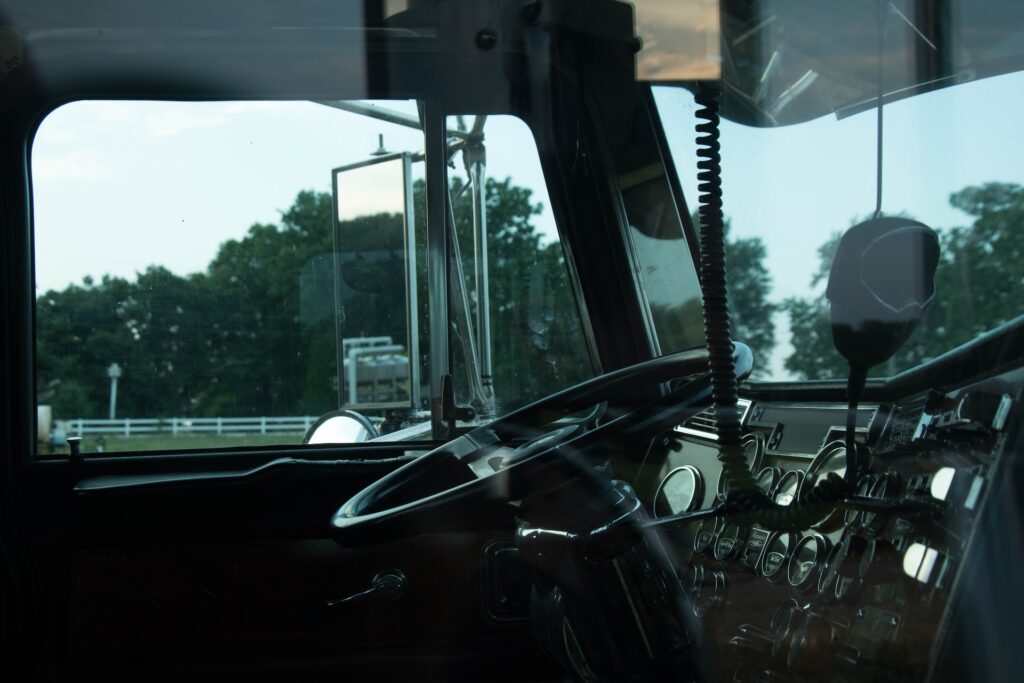Safety is of the utmost importance in the transportation industry. The proper truck windshield placement is a crucial aspect of truck safety. The strategic placement of windshields can significantly impact visibility, structural integrity, and overall road safety.

Photo by Jason Mitrione on Unsplash
This in-depth blog post will examine the factors that affect truck windshield placement, the applicable regulatory standards, the innovative technologies shaping the future, and the best practices for windshield replacement and repair. Join us as we investigate, with the customer in mind, the essential elements of truck windshield placement for optimal safety.
Do not miss Part 2 of our engaging blog series, “Truck Windshield Placement: Key Factors for Optimal Safety.” Join us as we uncover innovative technologies, best practices, and approaches that redefine how we prioritize road safety. Learn how these innovations are revolutionizing the transportation industry.
Table of Contents
ToggleThe Role of Truck Windshield Placement in Safety
Truck windshields play a crucial role in ensuring the protection of truck drivers and passengers, despite being a simple piece of glass that is frequently overlooked. Windshields provide a barrier between the driver and the outside environment and are necessary for a safe and secure journey. This section will investigate windshields’ significant role in truck safety, shedding light on their numerous functions and impact on accident prevention.
A Vital Guardian
The windshield is the first line of defense against various road hazards and protects truck occupants. It safeguards vehicles from flying residue, dust, gravel, and insects, which could otherwise impair visibility and cause distractions. By providing a clear view of the road ahead, the windshield enables drivers to anticipate potential road hazards and respond accordingly, reducing the likelihood of incidents.
Protection From the Elements
In addition, truck windshield placement plays a crucial role in protecting vehicles from severe weather. Rain, precipitation, and sleet can significantly diminish visibility and make driving dangerous. This enables the driver to navigate in adverse conditions with confidence.
Ensuring Optimal Visibility
Visibility is essential for transportation safety, particularly when driving large commercial vehicles with extensive blind spots. The windshield’s position and dimensions substantially affect the driver’s field of view and sightlines. Properly positioned windshields provide drivers with a broader and more distinct view of the road, reducing blind spots and improving overall road awareness. This lowers the probability of collisions with pedestrians and other vehicles.
Impact on Accident Prevention
According to statistics, poor visibility is the primary cause of accidents. Cracked or inadequately installed windshields pose a significant safety risk, jeopardizing the interior’s structural integrity in the event of a collision. On the other hand, a properly maintained and positioned windshield contributes to the structural integrity of the vehicle, thereby reducing the risk of severe injuries during collisions.
Importance of Appropriate Maintenance
Windshields require routine maintenance to preserve the vital safety function they serve. Even minor chips or cracks can propagate and eventually compromise the windshield’s structural integrity. When windshield damage occurs, fleet managers and vehicle owners must prioritize prompt repairs or replacements to preserve the windshield’s optimal condition for maximum safety.
Regulatory Standards and Guidelines
The safety of commercial vehicles on our roads is rigorously regulated to reduce the likelihood of accidents and protect drivers, passengers, and other motorists. Truck windshield placement is an essential safety feature, and regulatory authorities have established guidelines and standards to govern this aspect of vehicle design. This section will discuss the regulations and guidelines truck manufacturers, fleet administrators, and vehicle proprietors must follow regarding windshield placement.
Compliance with Department of Transportation (DOT) regulations
The Department of Transportation is primarily responsible for establishing and enforcing safety regulations for vehicles, including commercial haulers, in the United States. The Federal Motor Carrier Safety Administration (FMCSA) of the Department of Transportation (DOT) establishes specific guidelines for truck windshield placement to ensure optimal driver visibility.
Windshield Glazing Standards
Regulatory standards frequently include specifications for windshield glazing material, which pertains to the type and quality of glass used to manufacture windshields. Windshields must be constructed from safety glazing materials that meet specific requirements, ensuring that they are shatterproof and less likely to cause injuries in the event of an accident.
Height and Angle of Windshield Installation
The Department of Transportation and other regulatory agencies establish height and angle requirements for truck windshield placement and installation. The objective is to improve the driver’s visibility of the road and neighboring traffic by optimizing the driver’s line of sight and minimizing blind spots.
Size and Dimensions
Additionally, regulatory standards dictate the size and dimensions of windshields for various commercial vehicle categories. Windshields should be proportioned appropriately to guarantee adequate visibility and structural integrity.
Impact Resistance and Durability
Commercial vehicle windshields must meet specific requirements for impact resistance and longevity. They must resist various road hazards and debris without endangering the driver’s safety.
Compliance and Certification Testing
Manufacturers of commercial vehicle windshields must comply with certification and testing requirements to ensure that their products meet safety standards. This includes extensive testing for resistance to impact, visibility, and compatibility with safety features such as airbags and Advanced Driver Assistance Systems (ADAS). Click here to learn more about ADAS.
Local and International Regulations
In addition to national regulations, truck drivers and fleet administrators must also be aware of local or state-specific requirements, which may vary by region. Additionally, international transportation companies must adhere to the regulations of the countries in which they operate, which may differ from those of their home nation.
Factors Affecting Windshield Placement
Truck windshield placement (in commercial vehicles) is a crucial factor that directly affects driver safety, visibility, and road performance. To determine the optimal placement of a truck’s windshield, manufacturers, designers, and fleet managers must evaluate various significant factors. This section examines the numerous vehicle design, visibility, structural integrity, and aerodynamic factors that influence the positioning of the windshield on commercial trucks.
Vehicle Type and Design
The design and type of commercial vehicles play a significant role in determining truck windshield placement options. Different vehicle designs, such as conventional cabs, cabovers, and sleeper cabs, necessitate different windshield positions to accommodate the distinctive characteristics of each variety. It is necessary to consider the location of the cab in relation to the front axle and the vehicle’s overall dimensions to ensure that the windshield provides the driver with an unobstructed view.
Visibility and Sightlines
Placement of vehicle windshields must maximize visibility at all costs. The windshield should be positioned to offer the motorist a clear and expansive field of view, minimizing blind spots and enhancing road awareness. Moreover, the angle and height of the windshield and the driver’s seating position influence the driver’s field of vision. Proper positioning can considerably enhance a driver’s visibility of potential hazards, pedestrians, and other vehicles, thereby decreasing the probability of collisions.
Structural Integrity and Windshield Support
Truck windshield placement also affects the structural integrity of the compartment. The windshield is essential for maintaining the structural integrity of the compartment during collisions and rollovers. Properly positioned windshields enhance a vehicle’s structural integrity, thereby protecting the driver and passengers in the event of a collision.
Aerodynamics and Fuel Efficiency
Windshields directly affect a vehicle’s aerodynamics, which in turn affects its fuel economy. An inadequately positioned or designed windshield can have a negative impact on a truck’s fuel economy. However, strategically positioned windshields that reduce drag can reduce greenhouse gas emissions and save money.
Environmental Considerations
Frequent weather conditions under which trucks operate include extreme heat, sub-zero temperatures, and torrential rain or snow. Windshield placement must take into consideration these environmental factors. The correct slope and angle can improve water drainage during precipitation, prevent ice accumulation during frigid temperatures, and reduce reflection from direct sunlight.
Final Thoughts
As we conclude this comprehensive examination of critical factors for optimal safety in truck windshield placement, it becomes clear that strategic placement is more than just a piece of glass; it plays a crucial role in protecting drivers, passengers, and all road users.
A commitment to innovation and customer-centricity motivates the never-ending pursuit of optimal windshield placement safety. With each innovation, the transportation industry advances toward a safer, more efficient, and more environmentally conscious future.
As we continue on this path, it is evident that the transportation industry’s dedication to safety remains unwavering, ensuring that drivers can confidently navigate roadways with enhanced visibility and peace of mind. Let us continue to pursue optimal safety in the placement of vehicle windshields, mindful that every advancement benefits the industry and the greater good of society.
Book an Appointment Now!
Do not overlook the second installment of our blog series, “Truck Windshield Placement: Key Factors for Optimal Safety.” Join us as we investigate innovative technologies, best practices, and exciting future trends that will revolutionize windshield placement on commercial vehicles.
Get a quote from AutoGlass with Class immediately. Our knowledgeable technicians are adept at replacing and repairing windshields and use only OEM-grade glass for optimal performance. Click here to book an appointment to ensure safe travel on the road.




Recent Comments